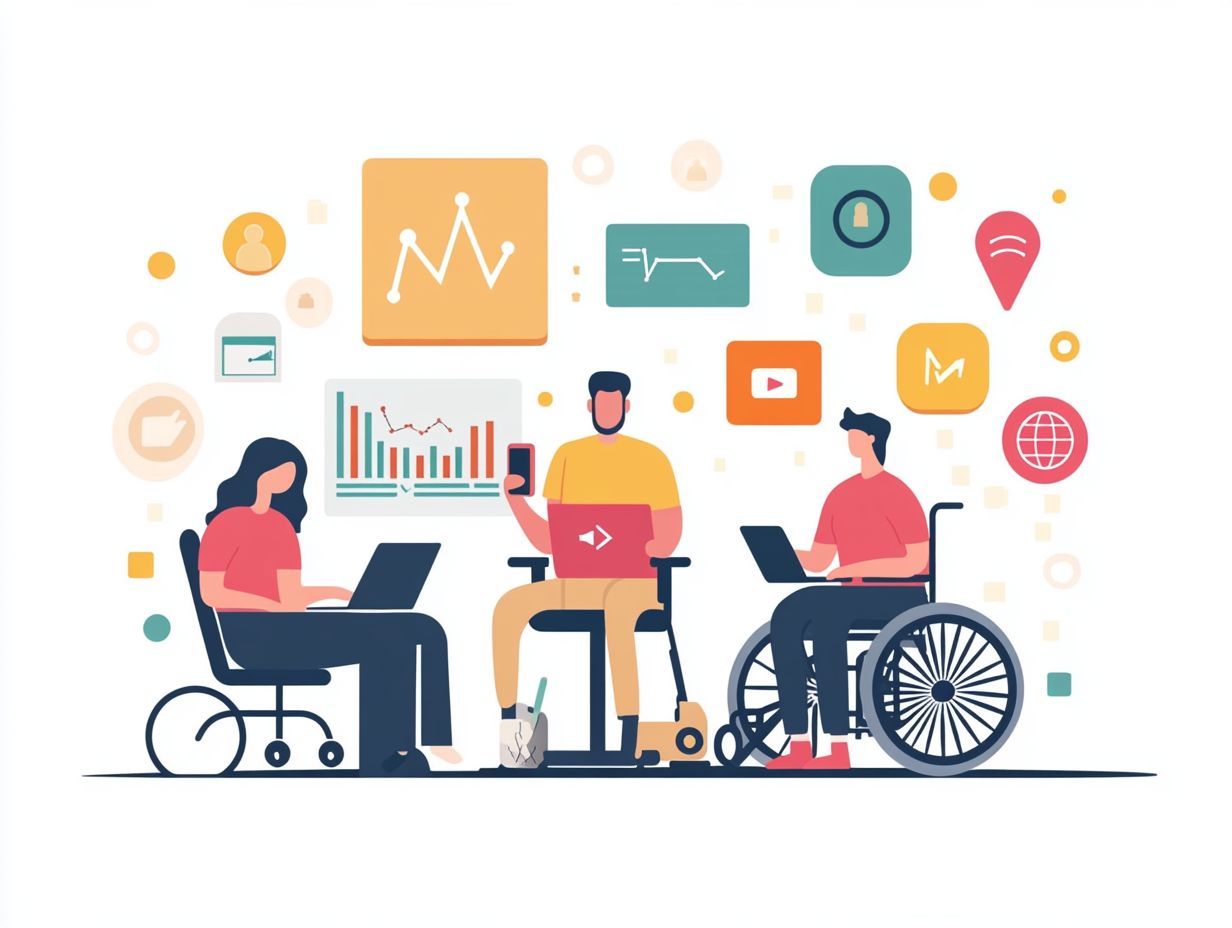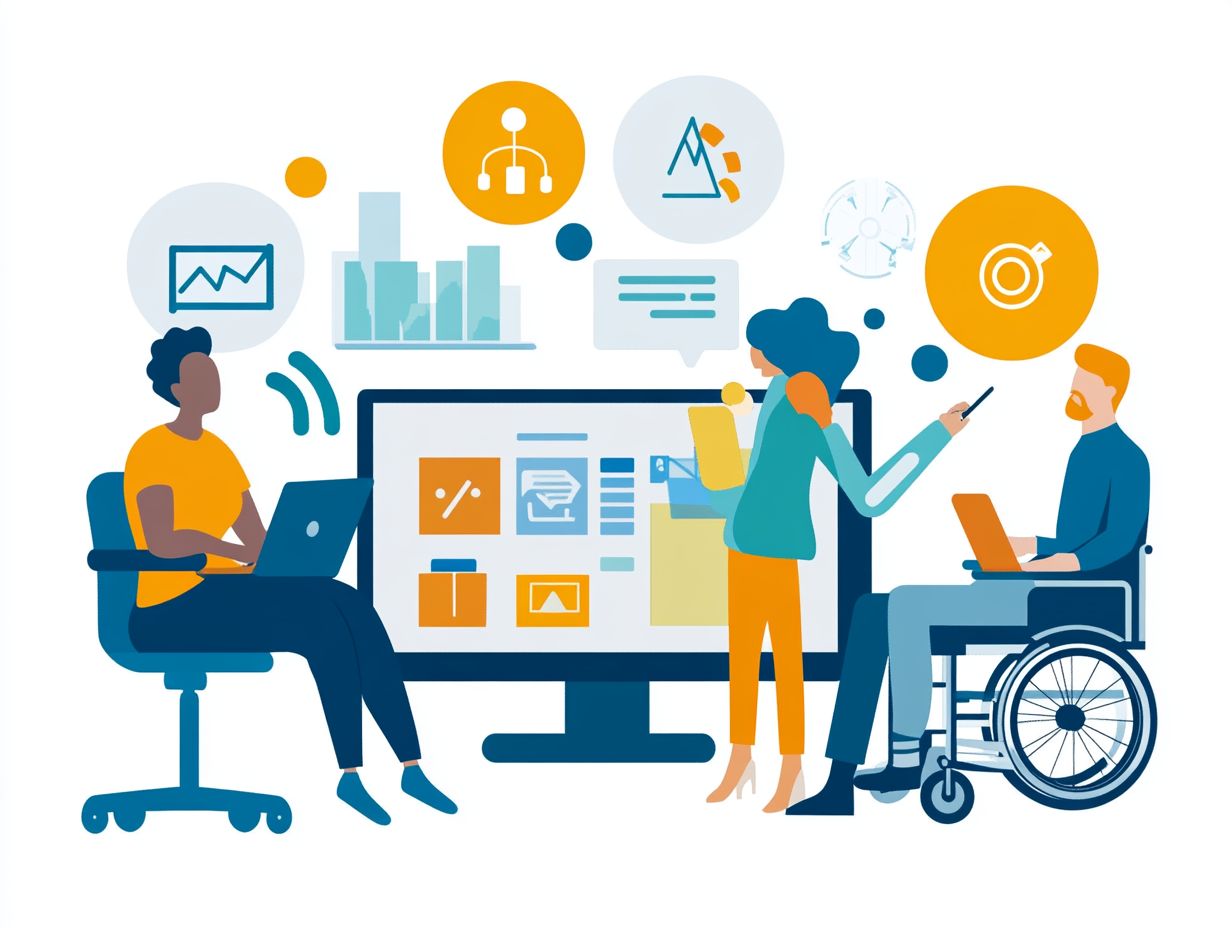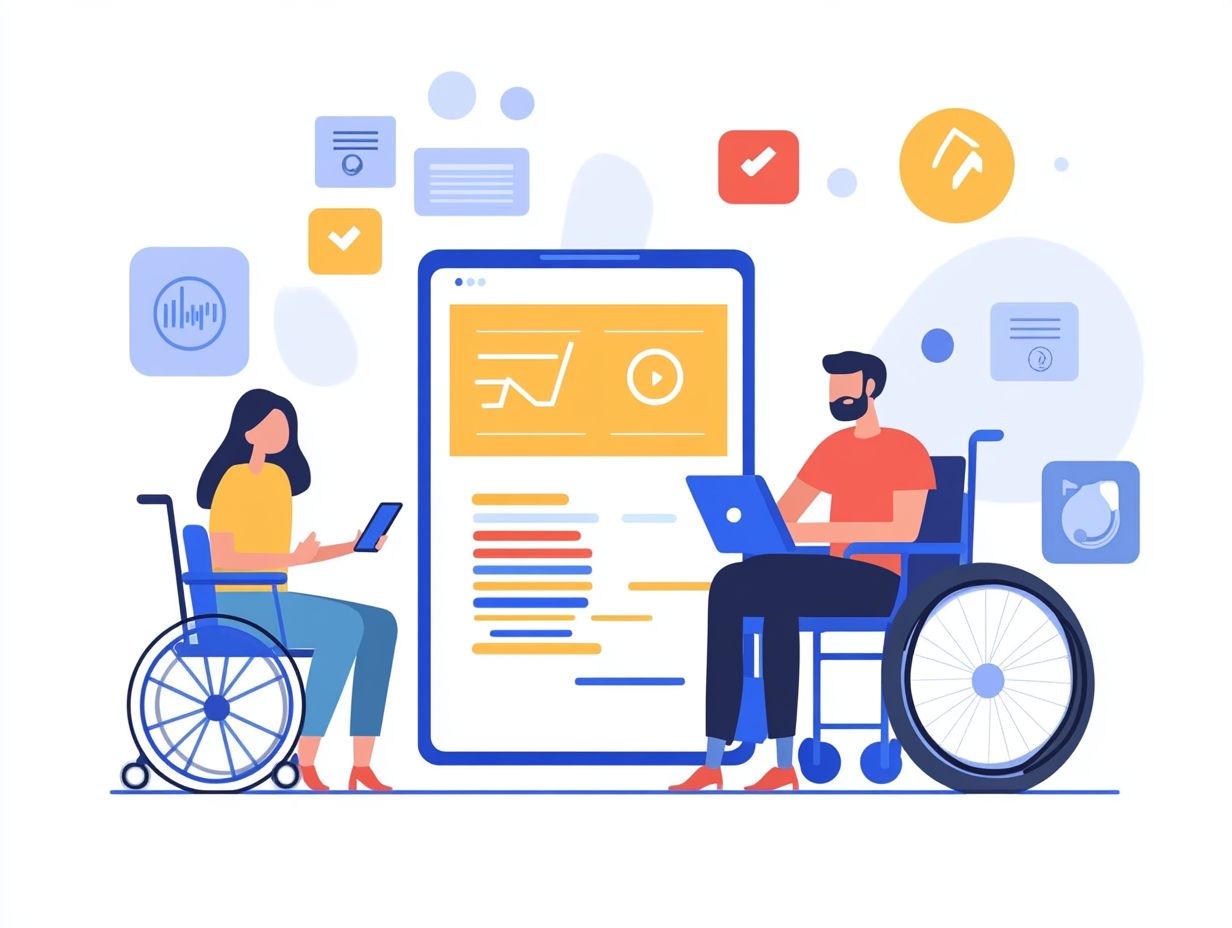How AI Can Improve Accessibility and Its SEO Impact
In today’s digital landscape, accessibility holds paramount importance, and technology is leading the charge in making resources more inclusive for all individuals.
With innovations ranging from natural language processing to image and speech recognition, these tools are dismantling barriers and enriching user experiences in remarkable ways.
This article delves into the myriad ways technology enhances accessibility, showcases its many advantages, and investigates the positive impact on search engine optimization (SEO).
Explore how harnessing these advancements can foster a more inclusive environment and elevate your online presence to new heights.
Contents
- How Can AI Improve Accessibility?
- What Are the Benefits of Using AI for Accessibility?
- How Does AI Impact SEO?
- Frequently Asked Questions
- How can AI improve accessibility for websites?
- What is the impact of AI on SEO for accessibility?
- Can AI help with optimizing website design for accessibility?
- How does AI improve website accessibility for users with visual impairments?
- Can AI improve website accessibility for users with motor disabilities?
- How can businesses benefit from using AI to improve website accessibility?
How Can AI Improve Accessibility?

Artificial Intelligence (AI) is transforming web accessibility, crafting inclusive digital experiences that cater to all users, particularly those with disabilities. By harnessing cutting-edge technologies like machine learning and natural language processing, AI significantly improves the capabilities of assistive technologies, making digital platforms easier to navigate and more user-friendly.
As you explore the evolving landscape of web accessibility, it s clear that AI is pivotal in meeting the varied needs of users, guaranteeing a seamless experience that aligns with accessibility compliance guidelines and fosters digital inclusion for everyone.
1. Natural Language Processing (NLP)
Natural Language Processing (NLP) is a fascinating subset of AI that equips machines with the ability to comprehend and interpret human language, greatly enhancing the user experience for individuals with cognitive disabilities. By leveraging the capabilities of NLP, digital platforms transform into more intuitive environments, allowing you to engage with content in a manner that feels both natural and accessible.
This remarkable technology has found its place in numerous applications, such as chatbots that elevate customer service and voice recognition systems that facilitate hands-free interaction. These innovations not only streamline your engagement but also ensure that your interactions are personalized and efficient. NLP is pivotal in content optimization, analyzing user preferences and behaviors to help create tailored experiences that resonate with you.
In this context, understanding user personas becomes essential. It enables developers to craft digital content that appeals to diverse audiences, fostering inclusivity and broader accessibility for everyone.
2. Image Recognition
Image recognition technology fueled by AI significantly enhances accessibility for visually impaired users by automatically generating alt text for images, which in turn improves overall web usability. This innovative approach guarantees that digital assets are not only recognized but also understood in context by screen readers, fostering a more inclusive online environment.
By integrating such technology into your web design, you not only boost user satisfaction but also align with essential content accessibility guidelines. This makes it simpler for all users to engage with digital platforms. When you utilize accurate alt text, you effectively bridge the gap between visual content and user experience, which can elevate your engagement metrics.
The additional context provided through well-crafted alt text allows users to connect more deeply with the content, enhancing their navigation experience and minimizing frustration.
Implementing image recognition tools can truly be a game-changer for you, ensuring that your online spaces are equitable and user-friendly for everyone.
3. Speech Recognition
Speech recognition technology, a vital aspect of AI, revolutionizes how you interact with digital platforms, especially if you have physical disabilities or visual impairments. By enabling you to navigate and control your online experience using voice commands, speech recognition significantly enhances usability and accessibility across a variety of devices.
This cutting-edge technology can be seamlessly woven into user interfaces, proving to be invaluable for mobile applications where touch input might present challenges. For those who find traditional input methods, like typing on small screens, cumbersome, voice commands offer a more intuitive and efficient way to engage with content.
Implementing speech recognition not only elevates your satisfaction as a user but also dramatically boosts conversion rates, allowing you to perform actions hands-free. The engaging nature of voice interactions fosters longer sessions, promoting deeper connections with apps or websites. Ultimately, this leads to greater acceptance of digital tools among diverse user groups, cultivating an inclusive environment that values all forms of interaction.
4. Predictive Text
AI-driven predictive text features significantly enhance your user experience by anticipating your input and suggesting relevant words or phrases. This is especially beneficial for individuals with disabilities who may struggle with typing. This assistive technology not only boosts communication but also streamlines content creation across digital platforms.
By minimizing the effort needed to type, these features give the power to you to express yourself more freely and efficiently. For those with mobility impairments or cognitive challenges, engaging in conversations, writing emails, or crafting social media posts becomes far less frustrating compared to traditional typing methods.
The implications for content distribution are noteworthy; as more people can share their thoughts with ease, a greater diversity of voices becomes visible online. Your feedback is instrumental in refining these algorithms, ensuring they meet the unique needs of various users. This ongoing refinement enhances the effectiveness and inclusivity of the technology, making it a vital resource for all.
5. Personalization

AI s remarkable ability to personalize user experiences based on your unique behavior and preferences fosters a deeper engagement and satisfaction, especially for those with diverse accessibility needs. This tailored approach guarantees that the content you encounter is not only relevant but also easily navigable, promoting true digital inclusion for everyone.
By analyzing your interactions and feedback, AI can offer recommendations that resonate with you and adapt over time, refining your journey as your preferences evolve. This leads to improved user engagement metrics, as you and others are more inclined to connect with content that speaks directly to you. As a result, this personalization significantly boosts conversion rates, making it an essential tool for businesses aiming to optimize their outreach efforts.
By gathering robust data analytics, organizations can continuously enhance their accessibility strategies, ensuring that you and all users enjoy a seamless and inclusive online experience.
What Are the Benefits of Using AI for Accessibility?
Integrating AI into your accessibility strategies presents a wealth of advantages that can profoundly elevate the user experience while boosting efficiency and cutting costs. By automating content accessibility assessments and enhancing the overall usability of your digital platforms, AI emerges as a transformative force in promoting digital inclusion.
1. Increased Efficiency
One of the key advantages of utilizing AI for accessibility is the significant boost it offers in website optimization processes. By automating repetitive tasks such as content accessibility audits and compliance checks, you can free up your team to concentrate on more strategic initiatives that truly matter.
For example, by harnessing machine learning algorithms, you can analyze vast amounts of user data to pinpoint areas on your website that present barriers to accessibility. With regular algorithm updates, these tools remain aligned with the latest accessibility standards and guidelines. This proactive approach not only simplifies the identification of accessibility issues but also enhances user engagement, leading to AI solutions for improving accessibility.
When you effectively reduce barriers through AI-driven solutions, users report higher satisfaction levels, which encourages more positive interactions and fosters increased loyalty. Ultimately, integrating AI in accessibility goes beyond mere compliance; it s about enriching the overall experience for every user who interacts with your site.
2. Improved User Experience
AI transforms user experience by elevating assistive technologies and refining user interfaces, making digital assets more accessible for individuals with disabilities. This shift ensures that you can navigate websites seamlessly and engage with content effortlessly.
By harnessing intelligent algorithms that analyze your behavior, platforms can tailor interactions to meet your diverse needs. Responsive design guarantees that, no matter the device be it a smartphone, tablet, or desktop you enjoy a consistent and fluid experience.
Integrating your feedback into the design process is essential; research highlights pain points and areas ripe for improvement, enabling developers to craft more intuitive interfaces. This collaborative approach not only enhances usability but also give the power tos you, fostering a sense of inclusivity and satisfaction that arises from an accessible digital environment.
3. Cost Savings
Utilizing AI for accessibility not only elevates your user experience but also translates into significant cost savings for your business by streamlining processes and ensuring compliance with accessibility standards. This proactive approach minimizes the risk of expensive legal challenges tied to accessibility non-compliance.
By harnessing AI-driven solutions, you can enhance your digital marketing efforts, broadening your reach to underserved audiences while simultaneously bolstering your brand image.
Regular website audits are essential in this framework, as they help you pinpoint potential accessibility issues before they escalate into legal complications. This ongoing assessment not only aids in maintaining compliance but also optimizes your operational costs, allowing you to allocate resources more efficiently.
Therefore, investing in AI accessibility solutions give the power tos you to create an inclusive online environment while safeguarding your financial interests.
How Does AI Impact SEO?

AI’s influence on SEO is nothing short of transformative. It not only elevates the user experience but also has a direct impact on your search rankings and website traffic.
With the capability of AI algorithms to analyze user behavior and preferences, you can optimize your content and digital assets more effectively than ever before.
1. Better User Experience
AI-driven technologies play a pivotal role in enhancing your user experience, a crucial element in your SEO performance. By analyzing user behavior and preferences, AI can tailor content and recommendations specifically for you, resulting in improved engagement metrics.
This personalized approach not only keeps you engaged but also encourages you to spend more time on a website something search engines recognize as an indicator of valuable content. For example, chatbots powered by natural language processing can provide you with instant support, addressing your queries in real-time and minimizing those pesky bounce rates.
AI algorithms are adept at predicting the types of content you re likely to engage with, leading to smarter content curation that aligns with your interests. Ultimately, these tools enhance your journey, fostering a deeper connection with the brand and improving your overall satisfaction. This, in turn, can elevate the site’s ranking within search engine results.
2. Improved Search Rankings
By leveraging the capabilities of AI technologies, you can significantly enhance your website s search rankings. AI enables more precise targeting of keywords and ensures that your content aligns seamlessly with user intent. This optimization is in perfect harmony with the evolving landscape of search engine algorithms, which increasingly favor quality over mere quantity.
With these advancements, AI systems can sift through vast amounts of data to pinpoint trending search terms, allowing you to focus on what users are actively seeking. This tailored approach not only elevates the relevance of your content but also drives organic traffic, as search engines are more inclined to showcase websites that resonate with user queries.
Staying ahead of algorithm updates is essential; those who embrace AI-driven strategies can quickly adapt their content to maintain visibility. By doing so, you ensure that you consistently meet users’ needs and expectations, setting yourself apart in the competitive digital landscape.
3. Increased Website Traffic
AI plays a crucial role in boosting your website traffic by refining your SEO strategies and honing your audience targeting methods. With its remarkable ability to analyze data and optimize content distribution, you can reach your target audience more effectively than ever.
This enhancement largely stems from AI s proficiency in sifting through vast amounts of data, identifying patterns and trends that can inform your content creation and distribution strategies. By leveraging advanced algorithms, you can tailor your website content not only to rank higher in search engine results but also to resonate with specific demographics that matter to you.
Integrating AI tools allows for real-time analysis, give the power toing you to adapt your strategies swiftly as audience preferences evolve. Consequently, this improved visibility attracts not just more viewers but fosters deeper engagement, ultimately leading to increased conversions and loyalty among your users.
Frequently Asked Questions
How can AI improve accessibility for websites?

AI can improve accessibility for websites by utilizing voice recognition software, image recognition technology, and natural language processing to make websites more user-friendly for those with disabilities. These tools can help websites provide better navigation and communication options, making it easier for users with visual impairments, motor disabilities, or cognitive disabilities to access and interact with website content.
What is the impact of AI on SEO for accessibility?
The impact of AI on SEO for accessibility is significant. By using AI technology to improve website accessibility, websites can achieve better search engine rankings, as search engines prioritize websites that are user-friendly and accessible for all users. This can lead to increased website traffic and visibility, which can ultimately benefit businesses and individuals.
Can AI help with optimizing website design for accessibility?
Yes, AI can help with optimizing website design for accessibility. With AI technology, websites can analyze user behaviors and patterns to identify areas of improvement for accessibility. This can include adjusting website layouts, font sizes and styles, color contrast, and alternative text for images to make them more accessible for users with disabilities.
How does AI improve website accessibility for users with visual impairments?
AI improves website accessibility for users with visual impairments by using image recognition technology and natural language processing. These tools can help websites provide alternative text for images and video content, as well as audio descriptions for visually impaired users. Additionally, AI can assist with screen reading software, making it easier for visually impaired users to navigate and understand website content.
Can AI improve website accessibility for users with motor disabilities?
Yes, AI can improve website accessibility for users with motor disabilities. By using voice recognition software and natural language processing, websites can provide voice command options for navigation and interaction. This can help users with motor disabilities who may struggle with using a traditional keyboard or mouse to access and interact with website content.
How can businesses benefit from using AI to improve website accessibility?
Businesses can benefit in several ways from using AI to improve website accessibility. By making their websites more user-friendly for people with disabilities, businesses can increase their customer base and reach a wider audience. This can also improve their brand reputation and showcase their commitment to inclusivity and accessibility. Additionally, better website accessibility can lead to improved SEO rankings, increased website traffic, and potentially more conversions and sales.






